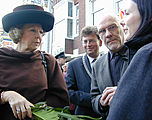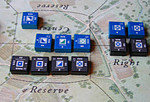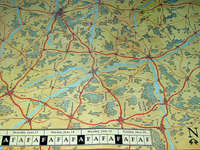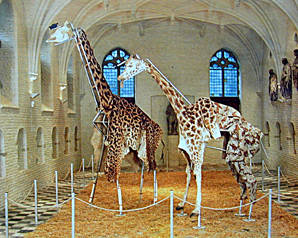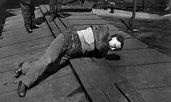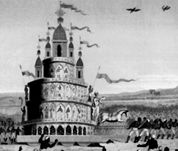|
|

|
||||||||||||||
|
|
Present Past Subjects Projects Misc |
NOVEMBER 1999
Fall
Slippage Tonight's lecture theme: 'Urban tendencies - artistic interfaces for acting in local and translocal environments'. One of the guests, Christian Hubler of Knowbotic Research, made a presentation about KR's installations and projects of the last year (over the tactical impact of their knowbotic agents?) where he showed that KR's incessant transforming, filtering and mapping of dynamic data leads only to chaos (and obscure artspeak). It was all 'smoke and mirrors' to me, and didn't make the slightest bit of sense. Nor could it be considered 'beautiful.' The point? Slippage. I once read that the words spoken by a patient as he or she puts their coat on at the end of a therapy session are often the most important -- and that the good therapist is aware of this. So too, Mr. Hubler's 'point' was revealed in his last comment of the Q & A session, when he interrupted the moderator's closing words to say that neither 'individual competences' nor 'social collaborations' seem able to deal with our changing social, political and economic conditions. Neither the individual nor the group has any future. Quixote Fight Club premiered this afternoon. We took seats 'in the front' of a nearly empty theatre for the 14:50 screening. The film was NOT what I expected from the little that I had heard and read... I wasn't prepared for it's comedy, it's silly 'Mr. Bean'-like atmosphere which cleverly twisted the story into a piece of insidious horror. Fight Club is clearly a film for and from this time. Perverse, disturbing, brilliant. Viva Cervantes. Lost Weekend So where have you been? Here. Feeding my interest in the design of German board games by playing around with my collection and researching the latest releases from the Game Fair in Essen. (I admit I've been doing this rather obsessively.) Where you going? I'm not sure, at least not in the long term -- though I'm convinced that board and card game mechanics can teach us a lot about designing 'experiences'. This week I'll be one of the tutors at a workshop on the design of 'city screens' (the page is in Dutch) or large digital billboards, for the Studium Generale of the Willem de Kooning Academie. The workshop should be interesting, the organisor has stated in the prospectus that the workshop is NOT about the economic or ethical aspects of such screens but about their cultural and 'expressive' aspects. He then goes on to ask questions which can only be answered if one considers contemporary economics and ethics. I'll keep you posted as to how this *problem* gets resolved. :-) Push and Pull Eye scream for ice cream. May I draw your attention to the rant: Design Urgencies between the Public and the Private that Jouke published yesterday (8.11.99) on NQPAOFU? To re-quote his Diamond Age quote: "Quite some time ago the content issue had been settled: tits, tires, and explosions were the only things that seemed to draw the notice of their supremely jaded focus groups, though from time to time they would play the juxtaposition card and throw in something incongruous, like a nature scene or a man in a black turtleneck reading poetry." This directly relates to the discussion at the workshop that I'm doing this week on 'City Screens' (where the expectation is to develop 'content' for 'public' screens costing millions.) I'm taking his rant back with me this morning to plow back into idea pool. (BTW: I learned a lot from the kids yesterday. It's nice to be around 50 smart, media savy, urban users.) That which is expressed is impressed... The City and its Screens
The City of God Half a century into the 'information age' do we still agree that urbanism in its physical form is explosive? Do we still feel that implosion is a good descriptor for the dynamics of virtual urbanism? THE RELATIONS: Implosion as incantation and virtual urbanism as seduction by charisma, structure by thought virus, order by advertising, all nice and ubiquitious through the grace of the net... The market, the infirmary, and the graveyard. Talking to Strangers "Again in speech we tend to react to each situation that occurs, reacting in tone and gesture even to our own act of speaking. But writing tends to be a kind of separate or specialist action in which there is little opportunity or call for reaction..." (McLuhan) Yesterday I happened to speak with a complete stranger, a fellow inhabitant of the city. We had a very pleasant conversation which left me feeling good and started me thinking about the *affective* difference between talking with strangers and writing with strangers. Writing (to or with strangers) seems to afford a condition of 'hypersegmentation' or isolation, while speech (to or with strangers) seems to afford the opposite, ie. a feeling of connection and being part of a community. Personally, I've always privileged writing over speech. Writing as medium seems to offer me the possibility of 'measuring my words' in a way that speech does not. Thinking about the McLuhan statement, I see writing as reactive as speech, but with the stimulus and response taking place internally rather than externally. Speech is socialising in a way that writing isn't. Speech can make you feel good in a way that writing can not.
Last week Eva Knutz had
Last day of the 'City Screens' workshop. Continuity and Culmination Author Tom Wolfe makes Teilhard de Chardin, Marshall McLuhan and E. O. Wilson simple in this essay in Forbes (via Robot Wisdom). Recommended. Especially if you've always been curious about the sociobiological project but were afraid to ask. Once the 'human meme-ome' has been mapped, the practice of art will become more precise than medicine: "Not only will they be able to morph illustrations on the digital computer, they will also be able to predict, with breathtaking accuracy, the effect that certain types of illustrations will have on certain types of brains..." BTW: Alamut commented on E. O. Wilson's excellent rant against postmodernism, 'Back From Chaos' in March 1998. 'Wilson's rule of thumb (heuristic) for judging philosophies: "To the extent that philosophical positions both confuse us and close doors to further enquiry, they are likely to be wrong."' Raining and dark. News Jet Ellens, partner of Media-GN graduate Rijk van Kooij, gave birth to a daughter Monday night. Jouke is busy doing great things over at NQPAOFU. I'm re-reading McLuhan in order to prepare for the 'Understanding Media Seminar' that I'll conduct (with my Minerva class) Friday in Groningen. Rented Lambchop's 'What Another Man Spills' from the library. I like it. Woke at 3:30 A.M. with random words and fragments of sentences dancing (like sugar plums?) in my head... Fuck the Melting Pot This morning to Amsterdam to meet and discuss with Femke, Angela, Bruno, Daniel and Hans the plans for the coming masterclass of the Rotterdam Film Festival. It looks like I'm going to be involved again, and I'm happy about it. The problem is the same as last year, but still interesting and relevant, namely to develop projects which span both television and the networked computer. Think: hybrid (high bred) content for hybrid media. So far, there are not as many applicants as last year. The theme, the future prospects of an 'intercultural society' (a theme mandated by the government which subsidises the 'class') appears to have scared off a lot of people and proposals. I was surprised by this but on second thought can imagine that the theme's appearance of political correctness might not inspire. But hey, who says that the intercultural society needs to be politically correct? I suggested that a couple of us head over to the UNPO which is headquartered in the Hague and talk about the information/experience affordances of the Chechen Republic Ichkeria or the Republic of the South Moluccas. Think: Tribal Media. In the new 'intercultural society' one site (design) will -- thankfully never -- fit all. Fuck Florida Amsterdam: sex and drug capital of the world. Overheard this morning on the train between the airport and Amsterdam central: a group of excited college students (male, apparently from Boston), fresh off the plane... Hey! Look at the snow. Naaaa! [Giggling] When I told the guys the other day that we were going on vacation for a week they said, 'What? To Florida?' [Laughter] Fuck Florida man! [Whoops and more laughter] Will, Goals, Tactics and Strategy
Jouke called yesterday -- to check on how I was doing since I've been so quiet lately -- and in the course of our conversation, posed the following question to me: If you could do anything you wanted to -- what would you do? I thought this was a very good question, especially if seriously entertained. For I, like everyone on this planet, am able to immediately conjure up all sorts of adolescent fantasies as possible answers, but not the *right* one. You know the sort of fantasies that you think of when you're asked, 'Say, what would you do if you won the lottery?' -- clichéd, knee-jerk, blown-out affairs with little or no depth. Or for that mattter, real appeal. Who really wants to drown in sex-drugs-and-rock-and-roll and retire to
Billboard: http://www.ikwilookrijkerworden.nl
So, what would I do -- if I could do anything I wanted? I don't have an answer, but I am willing to work on the problem -- especially since I've begun realising the fundamental differences between tactics and strategy. Tactics, for those who need to know, are short term manoeuvres to achieve short term goals (or responses to handle short term set-backs) whereas strategies are long term manoeuvres (or plans) made to achieve long term goals. So far, in my two score and three years, I see myself as behaving primarily in tactical mode. In other words, I've always aimed short term, always applied a little more *stress* than necessary to the work at hand and always (or nearly always) got what I wanted. What a bore you say. And I agree with you. The time has come (at least in my life) to define some long term goals and start to figure out the long term strategies necessary to achieve them. So, what would I do -- if I could do anything I wanted? The other day I broke out a wooden block wargame which I bought a few years ago but never played called Napoleon. I read the rules and laid out the pieces. The game is both elegant and educational, providing in a simplified form a fairly accurate model of the forces involved at Waterloo. To play the game one needs to understand the difference between winning tactics (win a battle but maybe lose the war) and winning strategy (maybe lose a battle but win the war) and strike the right balance between the two.
War, like business, is usually considered from a strategic perspective -- with the end in mind, while most art seems to be tactical, i.e. a pure response or at the most aimed at very short term goals. Nothing new here: ARTIST RESPONDS TO ENVIRONMENT WITH ART WORK. Strategy in art is suspect. About a month ago Mitsu wrote on Synthetic Zero: "There is a difference between preparation and planning; plans tend to assume that the future is predictable, that events can be made to unfold, as they say, according to plan. One prepares, however, for the unexpected, for things to happen out of the bounds of your plans. Plans involve trying to control events, but preparation means trying not to let events control you. I don't believe in too much planning, but I do believe in lots of preparation." (October 20, 1999) I like what Mitsu wrote. It makes sense to think in terms of (tactical) preparation rather than (tactical/strategic) planning. However I'm still bothered by the question of 'goals'. Tactics are not goal oriented. Tactics are about survival and, when considered this way, tactics are 'safe'. You spawn when you need to and you die. Strategies, on the other hand, are all about goals and are dangerous. You're on a mission from God when you've got strategies (and armed and dangerous to boot). 'What do you want to do?' 'Where do you want to go?' If you have an answer to these questions -- you have goals and should have strategies. Is it possible to achieve goals by simply being prepared? I don't think so. All artists should have goals IMO. From the Extropian Reading List: How to Gain Control of Your Time and Your Life (Amazon US) by Alan Lakein. Metascene link: Napoleon's Last Will and Testiment (Very touching document.) [1] Reminds me of the little girl in Kore-Eda Hirokazu's film 'After Life', who after being asked to name the 'happiest moment' of her life to take to heaven with her, selects the time she was on the 'Splash Mountain Ride' at Disney World. Have will, will travel. Q: From where do you plan your strategy? From what position? A: I've always felt that strategies could only be defined from relatively 'free' positions. Positions that have a grand overview of the whole system and are not pressed by daily engagements and their accompanying concerns. Consider the 'room with a view', the 'long vacation' or 'the day on drugs'. Each offers (or affords) the possibility of an overview, the privilege of putting things into perspective, the chance to take stock of one's circumstances...
Delusions of Grandeur Q: Consider the most radical 'physical' positions imaginable, places such as Mt. Athos, Everest, or the Moon. What sort of strategies emerge from these places? A: Excerpt from an interview with a landscape photographer who compiled a book of Moon photos (from Salon): "I will say that it's a documented fact that the astronauts were most often moved and transformed by being a million and quarter miles out in space. By seeing the vastness of the universe like humans have never seen it before. Some of them had religious experiences on the moon -- came back to become dedicated ministers for the rest of their lives. Others have even gone so far as to create a unified theory of science and religion. I think most of the astronauts were permanently moved to the edge of their psyches." An Auspicious Point of View... ... is called 'darshan' by the Hindus and can refer to a guru (person), a physical place, a shrine (thing), or an idea (philosophical perspective).Britannica.com provides this definition: Sanskrit DARSHANA ("auspicious viewing"), in Hindu worship, the beholding of an auspicious deity, person, or object. The experience results in a blessing of the viewer. The rathayatras (car festivals), in which images of gods are taken in procession through the streets, enable even those who in former days were not allowed to enter the temple to have darshan of the deity. The capability of darshan is also imparted by a guru (spiritual leader) to his followers, by a ruler to his subjects, and by objects of veneration such as pilgrimage shrines to its visitors. I like the notion that darshan is a special capability (an affordance) which can be imparted by specific people, places or things. Q: When can a point of view (or viewing) also provide a blessing? A: 'When what you are looking for -- is what is looking...'
Movable Observation Post/High View Point. 1993.
Listening to Messiaen's Harawi. The Art of Darshan Yesterday the Hindu term 'darshan' meant: the reciprocal attention getting/giving between a subject and an object (dead or alive) at some point in space-time resulting in the subject feeling 'blessed.' Think: the 'killer' website. The mystical experience. The spot. The point of view. Darshan... You are looking for it and it finds you. Bam! and things are never again quite the same. Tip: The transformation economy is going to follow the experience economy with either fine (tuned) art or fine (tuned) drugs as its major resource (today's secret weapons).
The Darshan of the Crowd Master McLuhan introduced a somewhat different concept of 'darshan' in his chapter on 'number' in Understanding Media (1964): "In India the idea of 'darshan' -- of the mystical experience of being in very large gatherings -- stands at the opposite end of spectrum from the Western idea of conscious values." Ignoring McLuhan's own 'understanding' of darshan (my first reading lead me to think of darshan in terms of the crowd rather than the mystical experience), the passage neatly illustrates the McLuhan's distinction between 'tribal' and 'individual' cultures. But why can't there be 2 kinds of darshan? Rather than drawing the line between the types of 'darshanic' experience along racial boundaries why not look into our own backyard and consider the ecstasy of the (football) stadium vs. the ecstasy of the art gallery? Or the ecstasy of the television viewer vs. the ecstasy of the book reader? "Resistence is futile," thinks the stage diver. The Irresistable Destructive Force
Global (village) mobility: "The word 'juggernaut', emanates from India. It comes from the large yellow chariot of the god Jagannath at Puri. Each year in June-July the image of the god is taken out with great ceremony so that the devotees might have a darshan, or vision, of the deity. The chariot is 45 feet high and has 16 wheels. The diameter of each wheel is seven feet. With the god go his brother Balabhadra and his sister Subhadra, also on large chariots. Devotees deem it a great honour to pull these big chariots. There have been occasions when, while heaving the thick ropes in the jostle, people have slipped and been run over by the wheels." From the India Times page on the Car Festival: "An atmosphere of almost hysterical devotion prevails on this day and in earlier years, devotees were known to have thrown themselves under the wheels of the rath in the hope of obtaining instant salvation." From the Coolest Place on Earth Today Site (July 13, 1999): "The chariots are pulled with thick ropes by 4,200 workers from the Temple (which incidentally employs 20,000 people!). The devout believe pulling these ropes assures them heavenly salvation. The giant raths are unwieldy and practically impossible to turn, and once they get started they are nearly unstoppable. Tens of thousands of ecstatic singing and dancing Hindus crowd in front of the chariots as they make their way through town." Will and Testament Last night I found a list of Dutch (ie. Dutch language) 'blogs: 2525 (Francisco van Jole) First (knee jerk) reaction: 'They're breeding like rabbits!' Second (knee jerk) reaction: 'I wonder how many of them are going to be around in 5 years?' Confession: I want Alamut to be around in 5 years. As a matter of fact, I want it to be around in 20 years -- even if I (God forbid) am not around. Alamut alive and learning... Q: How will this web log survive time and global information churn? Consider this note to be Alamut's *first* will and testament. The start of its *plan*. Darshan a-go-go baby... I love winter. We went for a walk on the beach. Culturele Constipatie
Culture is our Nature. One definition of culture, which I learned years ago from a specialist in corporate communications, is "How we do things around here." This is a pretty good definition, but not one you will find in the dictionary. It works, in any case, for corporate communications specialists whose job, after all, is to find ways to express and communicate the implicit understanding that exists within a specific culture to others. Take, for example, the pictogram shown above. This pictogram has been pasted on the doors of the toilets in camps for asylum seekers here in Holland to show, "How we do things around here," and avoid nasty cultural misunderstandings. However, after gazing at the toilet door for a bit, I can imagine another, more honest, definition of culture to be, "My House, My Rules." Ownership rules (at least in the Dutch 'asielzoekerscentrum'). Musing What's the difference between 'everything and nothing' and 'everything or nothing'? When exactly does everything become nothing? And why does it do so? Example sentences:
L.'s birthday today. Leaving tomorrow morning for Paris for a few days. Expect the next Alamut update on Sunday the 5th of December. (This afternoon I bought this book: 'The Year 2000: A Framework For Speculation on the Next Thirty-Three Years' by Herman Kahn and Anthony J. Wiener, published in 1967, for 2 Dutch guilders; and a 48 megabyte compact flash card for my Nikon 950, for 346.62 )
ALAMUT.COM is artist owned and operated.
|
|
||||||||||||


